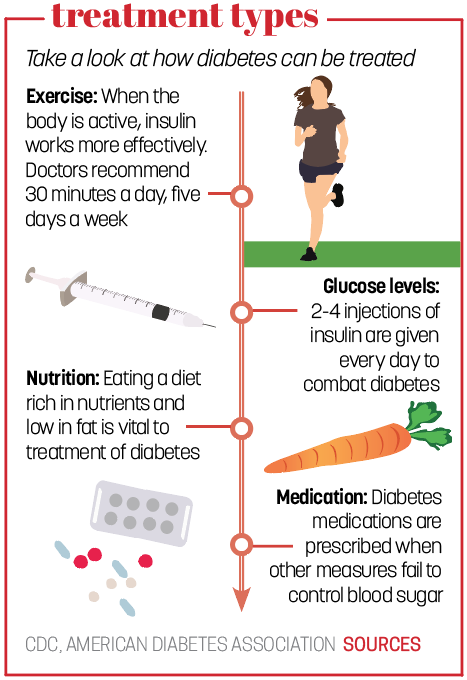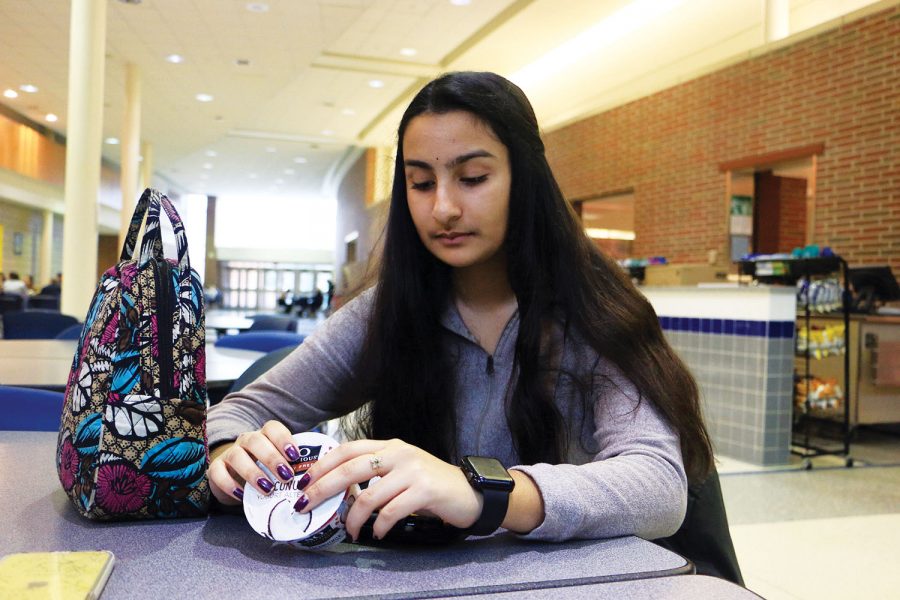Before fourth grade, sophomore Yashaswini “Yashu” Battina used to live much more at ease. She said that since her Type 1 diabetes diagnosis in fourth grade, her life has changed drastically.
“I’ve had to grow up faster as I’m responsible for making sure my body functions properly,” Battina said. “Also, I have to make sure I’m always taking medication on time and being aware of my body and how I feel.”
Even more, her amount of responsibility has changed throughout her schooling career.
“Earlier on, I had to go to the nurse’s office, but now I’m much more independent, and I can check (blood glucose levels) and be self-responsible,” Battina said. “Because I have new technology, I can just have a machine regulate (the checks), so it definitely relieves some of the responsibility. Of course that doesn’t mean that I can completely disregard how my body feels, but it definitely gives (me) a safety blanket.”

Tyler Lethen, Type 1 diabetic and sophomore, takes out diabetes test strips. Lethen said he uses these test strips to test his blood glucose levels after pricking his finger with a lancet and pressing the blood on the strip.
Type 1 diabetes, according to biomedical science teacher Richard Conley, occurs when someone doesn’t produce enough insulin, which is different from its counterpart Type 2 in which the insulin receptors are at fault. Despite different causes, Conley said both types have similar symptoms and treatments.
“Some symptoms include urinating frequently, fatigue and thirst, and they are usually the factors that lead someone to diagnosis,” Conley said. “Both types’ symptoms can be minimized through a balanced diet and regular exercise.”
The responsibility Battina bears as a result of diabetes is not uncommon, especially among adolescents; according to The National Library of Medicine, Type 1 diabetes is most prominent among adolescents. It occurs in 10 to 20 per 100,000 people per year in the United States. By age 18, about 1 in 300 people in the United States develop Type 1 diabetes.
Additionally, there has been a 2 to 5% increasing trend of Type 1 diabetes throughout the past 20 years.
Although there have been several hypotheses to explain the reason for both the cause and increasing trend such as, according to medical journalist Dan Hurley, lack of vitamin D levels and higher pollution levels, ultimately the official cause is unknown.

In order to alleviate some of these risks and symptoms, Battina said she followed through with a conscious decision to maintain a more healthy lifestyle.
“I definitely force myself to be more active and conscious of what food I eat,” Battina said. “I can’t just sit around and relax during breaks, and I have to refrain myself from eating too many sugary foods that I sometimes just crave.”
Although Tyler Lethen, Type 1 diabetic and sophomore, said he’s had a similar experience in how his responsibility has changed for checking his blood sugar levels, he didn’t have to change his lifestyle habits as much. In fact, he said he only further reinforced them.
“Type 1 diabetes hasn’t really changed me physically, I’ve always been active my whole life,” Lethen said. “The only thing that has really changed is me watching my blood sugar constantly. Not only that, but (also) watching how many carbs I take in. My pancreas failed, so now I have to do its job.”
Fortunately, in response to this trend, there has also been consistent improvement in technology.
“Before, you’d have to constantly poke yourself to check your blood sugar levels; however, now you can have a machine just automatically monitor it,” Conley said. “Furthermore, they have a pump, so that you don’t have to inject any insulin yourself.”
Both Battina and Lethen said they are grateful for the evolution of diabetic technology.
“After checking my blood sugar levels, I can input the amount of insulin I need into my Omnipod, which is just a little pod on my body that acts like a pancreas,” Lethen said. “I can focus less on making sure my body is doing its job, which helps alleviate the burden.”

Even though it’s easy to highlight the differences between a diabetic and non-diabetic person, Battina and Lethen said that they wish people would be more sensitive in their remarks and actions to avoid isolating them.
“Of course, people will stare at the things on my arms just like how you stare at something you’ve never seen before, but sometimes it can get annoying,” Lethen said. “I don’t bite, so stop staring and just come ask me, ‘What’s that on your body?’”
Battina said the best way for people to avoid unintentionally offending diabetics is to educate themselves.
“If you are going to talk about diabetes in a serious manner, please do your research,” Battina said. “Don’t make rash assumptions. Know what people to talk to because it can be a sensitive topic, but I definitely think it’s beneficial to be more aware of it.”
Check out a story about common misconceptions regarding Type 1 and 2 diabetes here.
































![What happened to theater etiquette? [opinion]](https://hilite.org/wp-content/uploads/2025/04/Entertainment-Perspective-Cover-1200x471.jpg)














































![Review: “The Immortal Soul Salvage Yard:” A criminally underrated poetry collection [MUSE]](https://hilite.org/wp-content/uploads/2025/03/71cju6TvqmL._AC_UF10001000_QL80_.jpg)
![Review: "Dog Man" is Unapologetically Chaotic [MUSE]](https://hilite.org/wp-content/uploads/2025/03/dogman-1200x700.jpg)
![Review: "Ne Zha 2": The WeChat family reunion I didn’t know I needed [MUSE]](https://hilite.org/wp-content/uploads/2025/03/unnamed-4.png)
![Review in Print: Maripaz Villar brings a delightfully unique style to the world of WEBTOON [MUSE]](https://hilite.org/wp-content/uploads/2023/12/maripazcover-1200x960.jpg)
![Review: “The Sword of Kaigen” is a masterpiece [MUSE]](https://hilite.org/wp-content/uploads/2023/11/Screenshot-2023-11-26-201051.png)
![Review: Gateron Oil Kings, great linear switches, okay price [MUSE]](https://hilite.org/wp-content/uploads/2023/11/Screenshot-2023-11-26-200553.png)
![Review: “A Haunting in Venice” is a significant improvement from other Agatha Christie adaptations [MUSE]](https://hilite.org/wp-content/uploads/2023/11/e7ee2938a6d422669771bce6d8088521.jpg)
![Review: A Thanksgiving story from elementary school, still just as interesting [MUSE]](https://hilite.org/wp-content/uploads/2023/11/Screenshot-2023-11-26-195514-987x1200.png)
![Review: "When I Fly Towards You", cute, uplifting youth drama [MUSE]](https://hilite.org/wp-content/uploads/2023/09/When-I-Fly-Towards-You-Chinese-drama.png)
![Postcards from Muse: Hawaii Travel Diary [MUSE]](https://hilite.org/wp-content/uploads/2023/09/My-project-1-1200x1200.jpg)
![Review: "Ladybug & Cat Noir: The Movie," departure from original show [MUSE]](https://hilite.org/wp-content/uploads/2023/09/Ladybug__Cat_Noir_-_The_Movie_poster.jpg)
![Review in Print: "Hidden Love" is the cute, uplifting drama everyone needs [MUSE]](https://hilite.org/wp-content/uploads/2023/09/hiddenlovecover-e1693597208225-1030x1200.png)
![Review in Print: "Heartstopper" is the heartwarming queer romance we all need [MUSE]](https://hilite.org/wp-content/uploads/2023/08/museheartstoppercover-1200x654.png)



